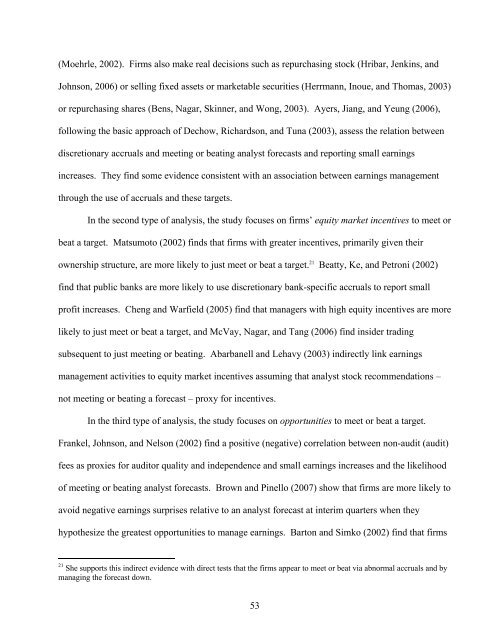Understanding earnings quality - MIT Sloan School of Management
Understanding earnings quality - MIT Sloan School of Management
Understanding earnings quality - MIT Sloan School of Management
Create successful ePaper yourself
Turn your PDF publications into a flip-book with our unique Google optimized e-Paper software.
(Moehrle, 2002). Firms also make real decisions such as repurchasing stock (Hribar, Jenkins, and<br />
Johnson, 2006) or selling fixed assets or marketable securities (Herrmann, Inoue, and Thomas, 2003)<br />
or repurchasing shares (Bens, Nagar, Skinner, and Wong, 2003). Ayers, Jiang, and Yeung (2006),<br />
following the basic approach <strong>of</strong> Dechow, Richardson, and Tuna (2003), assess the relation between<br />
discretionary accruals and meeting or beating analyst forecasts and reporting small <strong>earnings</strong><br />
increases. They find some evidence consistent with an association between <strong>earnings</strong> management<br />
through the use <strong>of</strong> accruals and these targets.<br />
In the second type <strong>of</strong> analysis, the study focuses on firms’ equity market incentives to meet or<br />
beat a target. Matsumoto (2002) finds that firms with greater incentives, primarily given their<br />
ownership structure, are more likely to just meet or beat a target. 21 Beatty, Ke, and Petroni (2002)<br />
find that public banks are more likely to use discretionary bank-specific accruals to report small<br />
pr<strong>of</strong>it increases. Cheng and Warfield (2005) find that managers with high equity incentives are more<br />
likely to just meet or beat a target, and McVay, Nagar, and Tang (2006) find insider trading<br />
subsequent to just meeting or beating. Abarbanell and Lehavy (2003) indirectly link <strong>earnings</strong><br />
management activities to equity market incentives assuming that analyst stock recommendations –<br />
not meeting or beating a forecast – proxy for incentives.<br />
In the third type <strong>of</strong> analysis, the study focuses on opportunities to meet or beat a target.<br />
Frankel, Johnson, and Nelson (2002) find a positive (negative) correlation between non-audit (audit)<br />
fees as proxies for auditor <strong>quality</strong> and independence and small <strong>earnings</strong> increases and the likelihood<br />
<strong>of</strong> meeting or beating analyst forecasts. Brown and Pinello (2007) show that firms are more likely to<br />
avoid negative <strong>earnings</strong> surprises relative to an analyst forecast at interim quarters when they<br />
hypothesize the greatest opportunities to manage <strong>earnings</strong>. Barton and Simko (2002) find that firms<br />
21<br />
She supports this indirect evidence with direct tests that the firms appear to meet or beat via abnormal accruals and by<br />
managing the forecast down.<br />
53
















